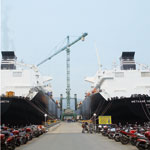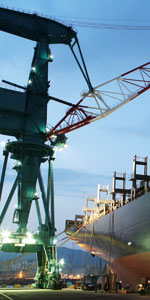Plain sailing for shipbuilding in Korea
In spite of fewer than 40 years in shipbuilding, South Korea has passed nations with a much longer history in this field. And Korean shipbuilders are absolutely confident of maintaining their world leading position.
DATE 2023-11-28 AUTHOR Birgitta LundbladIt is true that China is rapidly becoming increasingly important in shipbuilding and that Japan has long held a strong position in this industry. But with its some 34 per cent of the world market in CGT (Compensated Gross Tons, ships capacity measure), South Korea is the world’s largest shipbuilding nation today. Japan comes third with approximately 21 per cent of the market, and China has advanced strongly from a marginal player in the 90s to a present second position and a market share of over 22 per cent. It is evident that Asia is where the main shipbuilding activity takes place today.
Ship building is an important area for developing nations and Korea made shipbuilding a strategic industry for its economic development in the 1970s. Despite its shorter history in shipbuilding compared with Europe and Japan, Korea has developed a highly competitive and technologically advanced shipbuilding industry. Six Korean shipbuilders are ranked among the top ten in the world. Hyundai is the global top player followed by Samsung and Daewoo.
Being fiercely chased by the Chinese has in no way paralyzed the Korean shipbuilders. They strive continuously to keep several steps ahead and their quality and productivity are still superior. Hyundai and Samsung, for example, agree that threats and challenges from abroad only make them stronger and induce them to try even harder.
In recent years, the main Korean shipbuilders have focused strongly on value-added ships such as drilling ships, ultra-large container ships and LNG (Liquid Natural Gas) carriers. Korea is today the world’s leading LNG building nation. This sector is growing in importance in line with LNG becoming increasingly used as fuel source since it is comparatively clean. LNG consumption is forecast to grow by 25 per cent a year for the next decade and the world LNG fleet is expected to double to around 250 ships during this time. Hyundai, Daewoo and Samsung are winning the main part of the LNG contracts worldwide.
The Korean shipbuilding industry has recorded a historic high order volume in the last three years. In 2006, Korea’s order volume reached some 18.1 million CGT.
With their large current order backlog of as much as 41.4 million CGT, they have already secured a sufficient volume of work for the next 3 years. Therefore they can afford to adopt a selective strategy and continue to focus on high-priced ship types.
A new ship every fourth day
The Shipbuilding Division of Hyundai Heavy Industries (HHI) is the world’s largest shipbuilder with an impressive 15 per cent of the shipbuilding market. As of the end of 2006, the Division had delivered totally 1,230 ships of all types since its start in 1972.
In 2006 HHI’s Shipbuilding Division had a sales revenue of about USD 6.8 billion and set a new world record by exceeding a total of 100 million dwt (deadweight tons) in ship production, a doubling since 1997.
According to forecasts, Hyundai will build 77 ships this year meaning that a new huge vessel will slip into the water every third or fourth working day. Is it really possible to maintain a high quality standard with this exceptional production rate? “Thanks to our advanced manufacturing methods we manage to meet the high demands in quality as well as in capacity and cost efficiency,” says Lee Chul-hee, Senior Vice President of the HHI Shipbuilding Division.
Hyundai’s Ulsan shipyard located in south-eastern Korea spreads over a huge area of over 5 million square metres and includes nine dry docks of various sizes enabling construction of vessels of any type and size. The shipyard is a busy and exciting place where workers down at the dry docks look like dwarfs next to the enormous propellers. At HHI most shipyard functions apply computer technology from the daily administration of staff, through stock purchasing and control to ship design and manufacturing. CAD/ CAM programs are used from drawing up computer models of the vessels to the fully-automated steel cutting lines and welding robots in the production facilities.
The world’s greatest dock turnover rate
In contrast to its main competitor, Samsung Heavy Industries (SHI) has chosen to build a ship block factory in China in order to globalize its production and improve its competitiveness. With a sales revenue of about USD 6 billion and some 22,000 employees in 2006, SHI is the second largest shipbuilder in the world after Hyundai.
SHI forecasts that it will deliver some 50 ships during 2007. The largest part of the company’s design and construction concerns sophisticated ships such as drilling ships, shuttle tankers (used for oil transport from off-shore oil fields) and LNG ships. The company has an extremely strong position in these areas with almost 100 per cent of the world market of shuttle ships, 75 per cent of drilling ships and 35 per cent of LNG ships. The average price of the ships that SHI delivers is as much as 30 per cent higher than the average price of ships supplied by its competitors.
 Proof of Samsung’s production efficiency is that the largest dock at its Geoje shipyard in southern Korea has the greatest dock turnover rate in the world. This rate is a reliable way of measuring shipyards’ technical capacity and production efficiency. Dock No. 3 has a yearly turnover rate of 10 times for 30 ships. The efficiency is attained by using giant, floating cranes of 3,600 tonnes, producing mega-sized ship blocks, shortening the main engine loading time and applying various innovative production methods.
Proof of Samsung’s production efficiency is that the largest dock at its Geoje shipyard in southern Korea has the greatest dock turnover rate in the world. This rate is a reliable way of measuring shipyards’ technical capacity and production efficiency. Dock No. 3 has a yearly turnover rate of 10 times for 30 ships. The efficiency is attained by using giant, floating cranes of 3,600 tonnes, producing mega-sized ship blocks, shortening the main engine loading time and applying various innovative production methods.
Samsung’s efficiency has by no means been achieved at the expense of its quality standards. Actually, the Geoje Shipyard is the first to be certified with all the three international standards; ISO 9001 (Management Quality), ISO 14001 (Environment Management) and OHSAS 18001 (Safe and Healthy Working Environment Management).
“It is very important that the equipment onboard our ships is in line with our overall quality requirements,” says Park Chung-hum, Executive Vice President of Samsung’s Project Planning Division. “It should help us improve our performance as well as supporting our environmental endeavours.”
Present and future challenges
Hyundai and Samsung, like other shipbuilders in the world, are strongly influenced by the increased environmental focus and stricter regulations concerning issues such as carbon dioxide emissions and water pollution. They are keen on taking their responsibility and contributing to protect the fragile marine ecosystems.
“When ballast water is taken in by ships, water is transported from one ecological system to another which means that organisms are moved from one part of the world to another. This can cause serious ecological disturbances,” says Lee Chul-hee at Hyundai. “We welcome the enhanced consciousness of these problems as well as reliable and efficient technical solutions to the problems.”
Park Chung-hum of Samsung adds, “Environmental issues are without doubt becoming increasingly important for this industry and they have to be taken into account to a greater extent when judging the performance of a company instead of looking only at cost-efficiency and profits.”
Another challenge for the shipbuilding industry is the comprehensive cost increase of raw materials, particularly steel, in the last few years. This situation is caused by raw material shortage due, in turn, to the explosion in trade and the shipbuilding boom. Steel accounts for as much as 20 per cent of the materials in a ship, and margins are seriously squeezed since the ships that are delivered presently were ordered before steel prices rose and the US dollar fell.
The solution for Korean shipbuilders, apart from increasing the average price for the ships, is to continue to win more contracts for complex ships. Hyundai and Samsung agree that this is the way to go instead of fighting hard with the Chinese for contracts of less-advanced ship construction.
The two shipbuilding giants are confident about the future, relying on the Korean shipbuilding industry’s established position, its technical know-how and its capacity to adapt to and benefit from constant changes in the industry.

